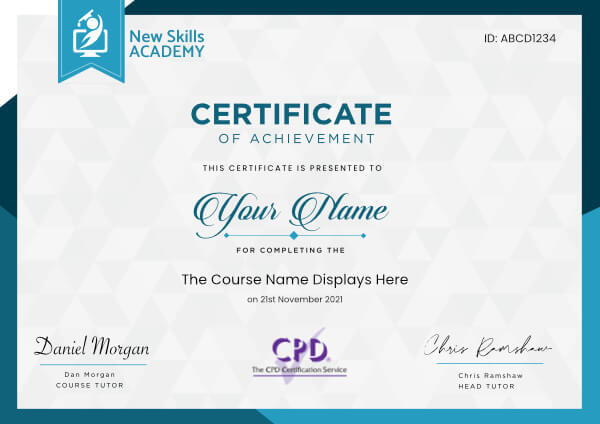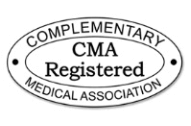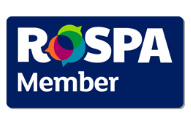The Complete Reducing Workplace Injuries Diploma
Includes the following courses:
Cable and Wire Management Certificate Display Screen Equipment (DSE) Awareness Certificate Eye Safety in the Workplace Certificate Head Protection Awareness Diploma Noise and Hearing Protection Certificate Noise and Vibration Awareness Certificate PPE Awareness Certificate RIDDOR Certificate Step Ladder Safety Awareness Certificate Working at Height CertificateThe Complete Reducing Workplace Injuries Diploma Course
This bundle addresses 10 key health and safety issues that all employers must take into consideration when drawing up risk assessments and implementing policies and procedures.
It addresses everyday issues, such as safe practices to follow when working with display screen equipment, and matters of special relevance to specific industries and tasks you may need to carry out only on an occasional basis, such as working at height.
By completing these courses, you will develop the knowledge you need to significantly reduce illness and injury at work.
What You Will Learn
This combined course includes the following:
- Cable & Wire Management Certificate
- Display Screen Equipment Awareness Certificate
- Eye Safety in the Workplace Certification
- Head Protection Awareness Diploma
- Noise & Hearing Protection Certificate
- Noise & Vibration Awareness Certificate
- PPE Awareness Certificate
- RIDDOR Certificate
- Step Ladder Safety Awareness Certificate
- Working at Height Certificate
Cable & Wire Management Certificate Course
Good cable and wire organisation is essential in the maintenance of a tidy workplace. However, there are also health and safety considerations to take into account. In this course, you will learn why cable and wires can be dangerous and the most appropriate ways to store them.
You will also learn why poor cable and wire management can impact employee performance, how to improve the lifespan of appliances and how to properly label wires and cables for quick identification.
Display Screen Equipment Awareness Certificate Course
Display screen equipment has revolutionised the workplace, but it carries health and safety risks that need to be appropriately managed.
This course explains how you can adjust your working practices to comply with the Health and Safety (Display Screen Equipment) Regulations.
You will learn about the role of eye care, employee training and workstation assessment in the prevention of injury associated with improper use of display screen equipment.
You will learn the minimum requirements concerning the provision of suitable equipment and how to meet your responsibilities under the law.
Eye Safety in the Workplace Certification Course
Eye injuries can result in blindness, so it is imperative that employees appreciate and follow training and procedures designed to protect eye health at work.
In this course, you will learn how to identify and assess potential risks, including chemical splashes. You will learn about the different types of eye protection available and how to choose the type that best suits your workers’ needs.
Head Protection Awareness Diploma Course
Head protection has a vital part to play in preventing head injuries in the workplace.
In this course, you will learn who is at increased risk of head injury and the legislation governing the prevention of head injury in the workplace. You will learn about the different kinds of protective headgear available and how to choose the right type for your needs.
The course also explains how to build a safety-centric culture.
Noise & Hearing Protection Certificate Course
Excessive levels of noise can cause temporary or permanent damage to an individual’s hearing.
This course outlines how loud noise affects wellbeing and productivity, and the laws surrounding noise and hearing protection in the workplace.
You will learn how to carry out a noise risk assessment and how to choose the best kind of ear protection for your needs. You will also learn how to reduce or resolve excessive noise by isolating and eliminating hazards.
Noise & Vibration Awareness Certificate Course
Excessive noise can result in hearing loss, and excessive vibration can cause nerve damage and musculoskeletal injury. In this course, you will learn how to comply with UK legislation governing exposure to noise and vibration in the workplace.
You will discover the measures employers must take to safeguard employee health, including health surveillance and the provision of suitable protective equipment.
PPE Awareness Certificate Course
PPE is highly effective in protecting workers from numerous risks, including chemicals, heat, noise and vibrations. All PPE use needs to be approved only after a comprehensive risk assessment, and it must always be carefully selected.
You will learn about the most common types of PPE used in the workplace, together with the questions you need to consider when selecting it.
You will learn how to store and maintain PPE and how to comply with UK PPE legislation.
RIDDOR Certificate Course
The Reporting of Injuries, Diseases and Dangerous Occurrences Regulations 2013 (RIDDOR) dictate how and when you must report significant occurrences in the workplace.
The scope of RIDDOR includes near-misses, injuries that necessitate absences lasting seven days or more, and occupational diseases, including Repetitive Strain Injury (RSI). You will learn what constitutes a “reportable occurrence,” the time frame in which you must file a report and how to record an incident.
Step Ladder Safety Awareness Certificate Course
Step ladders may not appear dangerous, but falling just one or two metres from height can cause serious injury. Step ladders are frequently used in most workplaces, so all employees must understand how to move and use them safely.
In this course, you will learn when to use a stepladder, how to maintain a stepladder, how to position your body to minimise the risk of injury and how to tell when a stepladder should be withdrawn from use.
Working at Height Certificate Course
Working at height can be extremely dangerous. This course will teach you why working at height may require extensive planning and how to mitigate risks to employees and members of the public. You will discover how to choose the most suitable preventative and protective measures that will safeguard employees working high above ground level.
The Benefits of Our Reducing Injury at Work Bundle
- You will learn the knowledge and techniques you need to mitigate and handle many different types of workplace hazard, thus keeping yourself and others safe
- You will learn how to carry out regular risk assessments
- This bundle will help you comply with your obligations under health and safety law
- These courses provide a comprehensive introduction to common workplace hazards, making this bundle valuable for anyone new to an HR role
This course includes
24/7 Student Support
End of course certification
Lifetime access to your course
Compatible with modern devices
This is a bundle course, and contains the following courses:
Cable and Wire Management Certificate Course
Wire and cable management – does it matter? Yes, and it goes way beyond just organisation. There are proper methods of cable and wire management that are necessary for performance, efficiency and appearances. But most importantly, it is vital to maintain proper wire and cable management for health and safety reasons. As an employer, it is necessary to keep your employees safe. Similarly, it is vital to ensure that clients are not exposed to any hazardous material or environments. Therefore, technicians are often encouraged to take a cable management course to keep themselves safe and to learn about proper wire and cable installations in order to keep their clients safe. However, not only technicians benefit from a cable and wire management course, but also individuals carrying out their own equipment installation, as well as those who want to learn better ways to organise their cables.
What you will learn in this course:
- What is cable and wire management and why is it important?
- Ways to organise wires and cables
- Where to apply proper wire and cable management practices
- How cable management can affect overall performance and efficiency
Benefits of this course
- Understand why proper cable and wire management is vital for safety and how proper installation allows for longer material lifespan
- Learn how to keep an electrical area clean and safe
- Learn how to effectively and neatly organise cables and wire without compromising on performance or efficiency
- Understand the dangers associated with poor cable and wire exposures and how to avoid electrical hazards
- Become familiarised with ways to label cables and how to trace and locate them without spending too much time trying to identify them
Display Screen Equipment (DSE) Awareness Course
Display screen equipment is an essential part of many jobs. It seems that almost everyone, including office workers, those conducting surveillance, and personal assistants spend most of their time staring at a screen as part of their job. While it is an inescapable part of the modern workplace, there are precautions that individuals should take to reduce the risks associated with long-term DSE exposure.
This course provides you with a comprehensive guide to assessing display screen equipment. It begins by giving you an introduction to the Health and Safety (Display Screen Equipment) Regulations, including a discussion of employee and employer obligations. The course also goes into detail about the minimum workstation requirements that must be met, as well as providing you with a series of tips to help you control and prevent DSE risks.
You Will Learn:
- Information about the Health and Safety (Display Screen Equipment) Regulations, including the rationale behind its development
- The minimum requirements all workstations governed by the Regulations must meet
- Employer obligations in relation to the DSE Regulations, including the provision of eye care, training and information
- How to conduct a workstation assessment and information about its form
- Tips on controlling and preventing DSE risks in your workplace
- The essential factors all individuals must consider when conducting their assessments
Benefits of Taking This Course
- Learning about the Health and Safety (Display Screen Equipment) Regulations and how they impact the workplace
- Gaining insight into the rights and obligations extended to employers and users under the DSE Regulations
- Understanding the minimum requirements each workstation covered by the DSE Regulations must meet
- Knowing how to conduct a workstation assessment, including the essential elements you need to keep in mind each time you complete one
- Learning helpful tips on how to control and reduce DSE risks at your workplace
Eye Safety in the Workplace Certificate Course
British laws require employers and companies to uphold safety regulations and safeguard their workers from injuries and accidents in the workplace. Eye accidents are very common in the workplace, but most can be prevented with the help of implementation of control measures, use of protective equipment and care. Most workers tend to be unaware of the risks associated with exposure to eye safety hazards and the adverse consequences that can arise. Eye injuries often result in permanent or temporary blindness with the loss of one or more eye functions.
The course on “Eye Safety in the Workplace” explains the following topics in detail:-
- The importance of maintenance of protective equipment and control measures in order to minimise or eliminate risks and hazards.
- How to protect workers from chemical splashes and what do in case of emergencies. You will also learn about how acidic and alkaline substances damage the eye in different ways.
- Exposure to radiation hazards from thermal, infrared, UV and bright light sources and how to protect workers from the risks.
- How staring at the computer for prolonged periods can lead to strain, headaches and blurred vision. You will also learn different techniques that help reduce eye strain.
- The types of protective eye equipment and their functions
The benefits of studying this course are described below:-
- You are in a better position to identify the different hazards that exist in your workplace.
- Employers can invest in the right safety equipment to safeguard their employees from injury.
- Businesses can upgrade prevention techniques, storage and maintenance of protective equipment for improved accident control.
- You can educate and update your employees on the risks and hazards associated with eye injuries.
Head Protection Awareness Diploma Course
Over one million people in England and Wales seek emergency or urgent treatment for head injuries every year. Some of these injuries occur in the workplace, particularly in high-risk industries such as construction and mining. Therefore, it is crucial that workers are adequately protected against the most common causes of head injury.
This course outlines the practical steps you need to take when choosing and using head protection at work, as well as the legal obligations which must be met by employers and employees under the law.
You Will Learn
- Why employers should take the issue of head protection seriously, the consequences of head injury, who is most at risk and the main pieces of legislation governing the use of head protection at work.
- The most common types of protective headgear used in the workplace, how safety helmets and bump caps reduce the risk of injury and how to choose the best type of head protection for your needs.
- The average lifespan of protective headgear, how to clean and store safety helmets and bump caps and the signs the suggest you need to replace them.
- Why workers need to comply with head and safety rules in the workplace, how to build a safety-centric work culture, the role of training in promoting compliance and why some employees are exempt from the rules the require them to wear head protection.
Benefits Of Taking This Course
- Anyone responsible for undertaking risk assessments and drawing up health and safety policies in a workplace will benefit from this overview of the proper use and care of head protection.
- If you are working as a health and safety trainer, this course will help you develop comprehensive training materials for those working in high-risk industries.
- This course will help those in supervisory roles encourage compliance in the workplace, thereby reducing the number of accidents that occur.
- If you are an employee in an industry that requires you to wear head protection, you will benefit from learning more about how head protection lowers your risk of injury.
- Anyone interested in the field of occupational health will find this course to be of interest, as it outlines the causes and consequences of head injury in the workplace.
Noise and Hearing Protection Certificate Course
One of the most important aspects of health and safety in the workplace is protection from noise hazards. Noise-induced hearing loss is described as the most preventable occupational hazard. In the UK, it is estimated that more than one million workers are exposed to noise hazards on a constant basis, thus increasing the risks of permanent hearing loss, reduction in productivity and increased employee absenteeism.
In the course on noise and hearing protection, you will learn about the following topics:
- The negative impacts of loud noise levels on health and wellbeing and the different types of noise, including variable, impulse, impact and continuous. You will also learn about Britain’s noise control laws and how employers are legally responsible for noise reduction measures in the workplace.
- How employers should consider regular risk assessments that help identify sources and the number of people exposed to noise hazards. You will also learn the industrial sectors that are known for higher noise hazard levels.
- How elimination and isolation of noise hazards help reduce noise and the important factors such as choosing the right places for machinery, checking for noise emission levels, fixing silencers and grouping together of machinery producing equivalent sounds.
- How the implementation of administrative controls such as planning activities outside of regular shift hours or outsourcing noise-producing activities to areas situated further away help noise reduction
- The different types of hearing protectors, including earmuffs and earplugs that help protect workers from noise hazards at work.
Important benefits of learning about noise reduction and hearing protection:
- Employers can ensure compliance with UK’s health and safety laws.
- You have the opportunity to understand how exposure to noise hazards can result in health risks.
- Employers can consider investing in personal protective equipment, such as specialised earmuffs and earplugs that are suitable to the conditions at work
- You can implement engineering controls at the planning stage to eliminate noise sources, as opposed to making changes later (which usually proves more expensive and less effective).
Noise and Vibration Awareness Certificate Course
Noise and vibration are two common workplace hazards that can have serious long-term effects on employee health. For instance, excessive noise can result in tinnitus and long-term hearing loss, whereas vibration can lead to musculoskeletal injuries and nerve damage. Fortunately, with diligent safeguarding measures, employees do not have to endure adverse health effects.
In this course, you will learn more about the risks associated with noise and vibration, and how employers and employees alike can play a role in creating a safer workspace.
You Will Learn:
- Why high levels of workplace noise are dangerous
- The legislation that addresses workplace noise and what an employer must do to comply with these laws
- The measures an employer must take to protect their workers’ hearing, including measuring noise levels, providing protective equipment and implementing health surveillance
- The two categories of workplace vibration and their effects
- What employers can do to protect their workers from injury caused by excessive vibration, and the health and safety legislation that sets out maximum acceptable vibration levels
Benefits of Taking This Course:
- If you work in a role that exposes you to high levels of noise or vibration, this course will help you take practical steps to safeguard your health
- If you are an employer, this course will help you meet your obligations under health and safety law
- If you have an interest in occupational health, this course will provide a good introduction to two of the most common workplace hazards
- If you are in a supervisory role, this course will help you check that your team are adhering to health and safety policies and provide guidance if necessary
PPE Awareness Certification Course
Personal Protective Equipment (PPE) protects workers in many fields from injury and disease. However, the decision to use PPE should not be undertaken lightly and should be used only as a last resort when other risk reduction measures do not work. In this course, you will learn how and when it is appropriate to use PPE, what you need to bear in mind when choosing it and how to get the most from your equipment. The course also addresses employers’ and employees’ duties under health and safety laws.
What You Will Learn
- The main types of PPE available, how it protects people from harm and the legislation governing its use and selection
- How to choose the correct type of PPE for your workers, taking into account their circumstances, job type and individual needs
- How to store and maintain PPE, why it should be tested on a regular basis and when it should be inspected
- Why a good training program will improve compliance with PPE policies in the workplace, barriers to training and the components of a successful training session
Benefits of Taking This Course
- If you are an employer, you will benefit from understanding your obligations under the law with regards to the provision and use of PPE
- If you are a worker who uses PPE, this course will further your understanding of why PPE is used, the different types of PPE available and why it should be used only as a last resort
- If you are responsible for the storage of PPE, this course will help you keep it in good working order
- If you are responsible for conducting risk assessments at work, you will benefit from this overview of the role of PPE and when it should be used
RIDDOR Certificate Course
Reporting accidents, injuries and occupational illness in the workplace allows organisations and authorities to learn how to identify and handle risks. Reports can inform future policy at both a local and national level. In the UK, the Reporting of Injuries, Diseases and Dangerous Occurrences Regulations 2013 (RIDDOR) decrees how and when people must report specified “reportable instances” to the Health and Safety Executive (HSE) and local government authorities. This course provides an overview of RIDDOR from both a theoretical and practical perspective.
You Will Learn
- What RIDDOR is, its scope and the general criteria that determine whether an incident is reportable.
- The types of injuries you must report under RIDDOR including burns, amputations and “over-seven-day” injuries
- The occupational diseases and dangers you must report, including carpal tunnel syndrome, RSI and “near-misses”
- Who should make a RIDDOR report, how to file a report and the time frame in which you must submit the report
Benefits of Taking This Course
- If you are an employer, you will benefit from acquiring a background knowledge of RIDDOR because it covers all businesses and work activities
- If you are responsible for health and safety-related matters at work, knowing the key points contained within RIDDOR will give you the confidence to judge whether an incident is reportable
- If you are interested in occupational health, this course will give you a useful insight into how UK authorities investigate accidents, injuries and near-misses in the workplace
- This course will help you complete timely, useful reports in the event that a reportable incident occurs in your workplace
Stepladder Safety Course
Workplace accidents can have serious consequences for both the casualty and their organisation. It is important that both employees and their employers understand the risks associated with working from height and that they know how to use equipment in a safe, appropriate manner.
An individual can sustain an injury falling just a couple of metres. They can also suffer a back injury if they fail to take precautions when moving and positioning equipment. Stepladders are used frequently in the workplace, so it is essential that employees know when and how to use them.
This course will provide you with a comprehensive overview of the risks associated with stepladders, how to put in place effective precautionary measures and how to ensure that equipment is fit for purpose.
Not all accidents are preventable, but when everyone knows how to work safely, the majority of incidents can be avoided.
You Will Learn:
- Why you need to take the risk of accidents and injury seriously and why the proper use of stepladders should be of concern to all employees and employers.
- How to assess whether a stepladder is the most appropriate form of equipment for a task and the factors you must take into consideration when conducting a risk assessment.
- How to check that a stepladder is fit for purpose, how to spot the signs that indicate it should be withdrawn from use and how to ensure that a faulty piece of equipment is not used by mistake.
- What you need to remember when working with a stepladder, including how to position your body and work effectively with tools whilst carrying out a task.
- How to move and store a stepladder safely and securely, taking into account its material, intended purpose and points of structural vulnerability.
Benefits Of Taking This Course:
- You will be able to use a stepladder confidently and safely, both at home and in the workplace.
- You will be able to offer guidance to others who are inexperienced in stepladder use.
- You will have a greater understanding of health and safety concerns at work, which is especially beneficial if you are in a management or HR role.
- You will be in a position to advise your organisation regarding stepladder and work at height policies, which may make an appreciable difference to the number of accidents recorded at your place of work.
Working at Height Certificate Course
Full knowledge of all aspects of ‘working at height’ is vital for both employers and employees in the relevant industries in order to maintain a safe, productive and legal business.
This course provides a comprehensive insight into every aspect of ‘working at height’, how to do it properly, the potential hazards involved and how you can keep your company and workers safe.
From discussing the different industries involved to highlighting the dangers and explaining the safety and legal measures needed, this course covers every aspect that everyone involved with ‘working at height’ needs to know.
You Will Learn
- The basic definition and history of ‘working at height’
- The different industries and jobs that involve ‘working at height’
- All the hazards and safety risks involved
- Prevention and safety measures needed
- The legal and regulatory obligations for anybody involved with ‘working at height’
Benefits of Taking This Course
- You will be able to determine the safety risks in your work environment
- You will be able to identify and eliminate any potentially life-threatening hazards
- You will understand the legal requirements of ‘working at height’ and provide advice in your work environment
- You will understand the regulations which govern ‘working at height’ and provide invaluable advice in your workplace
- You will be able to perform a basic safety inspection and write up a safety report
 ID: YDFT67YHJ
ID: YDFT67YHJ
of achievement
This certificate is presented to
Your Name

For completing the
The Complete Reducing Workplace Injuries Diploma
on 21st November 2024
Selena Hurford
Selena Hurford
Course Tutor

Daniel Morgan
Daniel Morgan
Head of Academy

Anyone who has an interest in learning more about this subject matter is encouraged to take the course. There are no entry requirements to take the course.
The course is broken down into 0 individual modules. Each module takes between 20 and 90 minutes on average to study. Although you are free to spend as much or as little time as you feel necessary on each module, simply log in and out of the course at your convenience.
You can study the course any time you like. Simply log in and out of the web based course as often as you require. The course is compatible with all computers, tablet devices and smart phones so you can even study while on the move!
Once you have completed all 0 modules there is a multiple choice test. The questions will be on a range of topics found within the 0 modules. The test, like the course, is online and can be taken a time and location of your choosing.
The pass mark for the test is 70%.
If you don’t pass the test first time you will get further opportunities to take the test again after extra study. There are no limits to the number of times you can take the test. All test retakes are included within the price of the course.
Once you have completed your test you can log in to your account and download/print your certificate any time you need it. If you would prefer us to post you a certificate to a UK address, there will be an admin charge of £10 (certificates sent internationally may cost more).
You can either use your Visa, MasterCard, American Express, Solo cards or PayPal account to pay for the online course. Our site uses the latest SSL encryption to ensure your safety. All payments are handled securely by PayPal.
You can begin the course immediately after your payment has been received. You will create your login details during the checkout process. We will also send you an email confirming your login details.
We estimate that the course will take about 28 hours to complete in total, plus an additional 30 minutes for the end of course test.
Once you have been awarded your certificate it is valid for life. The certificate does not expire or need renewing.
I really enjoyed this course. Was a lot of reading and had to stop and try to take it in.
There were 21 modules, and most of them took 45 minutes to complete, so you need to be in a position, where you actually have the time to do all the tasks that are required. The tasks are mainly to do things by yourself to practise what you have just read, but doing it will help you out so much.
Will be looking for another course, as I enjoyed this so much, definitely worth the price as the certificate is worth more on your cv.

Danielle Booth
I have found this course very interesting. Even being a bride myself, you don't actually realise how much actually goes into planning a wedding. Every little detail goes into the course. I can’t wait to start putting my work into action - becoming a Wedding Planner and being part of a couple’s day. Helping them plan their most important day of their lives. It’s been interesting learning how other cultures plan and have their weddings, and how many different themes people choose from. Even to the honeymoon. So many things go into being a wedding planner, it’s not as simple as it seems.

Kelly Ford
Really interesting and a good starting point for increasing my understanding and knowledge. Easy to access at any time, modules were nice and short so good bursts of information and easy to understand. I feel that I have gained knowledge that I can take forward within my current profession and apply my knowledge to get the best possible results for my organisation in all forms of media. Would recommend this course for anyone looking to start off in this career and looking to gain solid background information to take you forward. You have the flexibility to learn in your own time and take it at your own pace which is great when you are already working full time.

Sophie Graham
I decided to take this course to help me understand my 8 year old son with ADHD and ASD.
I managed to join the course and find the site with ease and after making my payment it was easy to start to find my documents and download my test sheets after the relevant modules.
I found other links which I am yet to explore further and can see me contacting a few of the organisations mentioned. I now am to put some strategies to the test.
The information was useful and I learnt a lot and got a certificate at the end. Thank you.

Nicki Openshaw
I rate this course very highly as this is a very in-depth informative online course that increased my knowledge in Marketing and has given me plenty of useful information to apply to my work.
It had a good framework of information followed by a worksheet so that you could test the knowledge that you’ve just learned. It provided a great deal of information broken down into easy to digest sections and was good value for money as well.
I would definitely recommend this course to others and I know that my brother has taken another course using this website also.

Hannah Pugh
I love the course very straight forward. Would love to know if there are any more courses available like this for advancement. Everything is clearly explained and if you get in trouble there is a helpline you can call. There should be more courses like this available online to benefit those people that want to go to work in their chosen field but are unable to pay for a program at college or else where. Well done and thank you for allowing me to pursue my interest and hopefully a career at the end of my studying.

Jo Debbage-lodge
The Complete Reducing Workplace Injuries Diploma Course
This bundle addresses 10 key health and safety issues that all employers must take into consideration when drawing up risk assessments and implementing policies and procedures.
It addresses everyday issues, such as safe practices to follow when working with display screen equipment, and matters of special relevance to specific industries and tasks you may need to carry out only on an occasional basis, such as working at height.
By completing these courses, you will develop the knowledge you need to significantly reduce illness and injury at work.
What You Will Learn
This combined course includes the following:
- Cable & Wire Management Certificate
- Display Screen Equipment Awareness Certificate
- Eye Safety in the Workplace Certification
- Head Protection Awareness Diploma
- Noise & Hearing Protection Certificate
- Noise & Vibration Awareness Certificate
- PPE Awareness Certificate
- RIDDOR Certificate
- Step Ladder Safety Awareness Certificate
- Working at Height Certificate
Cable & Wire Management Certificate Course
Good cable and wire organisation is essential in the maintenance of a tidy workplace. However, there are also health and safety considerations to take into account. In this course, you will learn why cable and wires can be dangerous and the most appropriate ways to store them.
You will also learn why poor cable and wire management can impact employee performance, how to improve the lifespan of appliances and how to properly label wires and cables for quick identification.
Display Screen Equipment Awareness Certificate Course
Display screen equipment has revolutionised the workplace, but it carries health and safety risks that need to be appropriately managed.
This course explains how you can adjust your working practices to comply with the Health and Safety (Display Screen Equipment) Regulations.
You will learn about the role of eye care, employee training and workstation assessment in the prevention of injury associated with improper use of display screen equipment.
You will learn the minimum requirements concerning the provision of suitable equipment and how to meet your responsibilities under the law.
Eye Safety in the Workplace Certification Course
Eye injuries can result in blindness, so it is imperative that employees appreciate and follow training and procedures designed to protect eye health at work.
In this course, you will learn how to identify and assess potential risks, including chemical splashes. You will learn about the different types of eye protection available and how to choose the type that best suits your workers’ needs.
Head Protection Awareness Diploma Course
Head protection has a vital part to play in preventing head injuries in the workplace.
In this course, you will learn who is at increased risk of head injury and the legislation governing the prevention of head injury in the workplace. You will learn about the different kinds of protective headgear available and how to choose the right type for your needs.
The course also explains how to build a safety-centric culture.
Noise & Hearing Protection Certificate Course
Excessive levels of noise can cause temporary or permanent damage to an individual’s hearing.
This course outlines how loud noise affects wellbeing and productivity, and the laws surrounding noise and hearing protection in the workplace.
You will learn how to carry out a noise risk assessment and how to choose the best kind of ear protection for your needs. You will also learn how to reduce or resolve excessive noise by isolating and eliminating hazards.
Noise & Vibration Awareness Certificate Course
Excessive noise can result in hearing loss, and excessive vibration can cause nerve damage and musculoskeletal injury. In this course, you will learn how to comply with UK legislation governing exposure to noise and vibration in the workplace.
You will discover the measures employers must take to safeguard employee health, including health surveillance and the provision of suitable protective equipment.
PPE Awareness Certificate Course
PPE is highly effective in protecting workers from numerous risks, including chemicals, heat, noise and vibrations. All PPE use needs to be approved only after a comprehensive risk assessment, and it must always be carefully selected.
You will learn about the most common types of PPE used in the workplace, together with the questions you need to consider when selecting it.
You will learn how to store and maintain PPE and how to comply with UK PPE legislation.
RIDDOR Certificate Course
The Reporting of Injuries, Diseases and Dangerous Occurrences Regulations 2013 (RIDDOR) dictate how and when you must report significant occurrences in the workplace.
The scope of RIDDOR includes near-misses, injuries that necessitate absences lasting seven days or more, and occupational diseases, including Repetitive Strain Injury (RSI). You will learn what constitutes a “reportable occurrence,” the time frame in which you must file a report and how to record an incident.
Step Ladder Safety Awareness Certificate Course
Step ladders may not appear dangerous, but falling just one or two metres from height can cause serious injury. Step ladders are frequently used in most workplaces, so all employees must understand how to move and use them safely.
In this course, you will learn when to use a stepladder, how to maintain a stepladder, how to position your body to minimise the risk of injury and how to tell when a stepladder should be withdrawn from use.
Working at Height Certificate Course
Working at height can be extremely dangerous. This course will teach you why working at height may require extensive planning and how to mitigate risks to employees and members of the public. You will discover how to choose the most suitable preventative and protective measures that will safeguard employees working high above ground level.
The Benefits of Our Reducing Injury at Work Bundle
- You will learn the knowledge and techniques you need to mitigate and handle many different types of workplace hazard, thus keeping yourself and others safe
- You will learn how to carry out regular risk assessments
- This bundle will help you comply with your obligations under health and safety law
- These courses provide a comprehensive introduction to common workplace hazards, making this bundle valuable for anyone new to an HR role
This course includes
24/7 Student Support
End of course certification
Lifetime access to your course
Compatible with modern devices
This is a bundle course, and contains the following courses:
Cable and Wire Management Certificate Course
Wire and cable management – does it matter? Yes, and it goes way beyond just organisation. There are proper methods of cable and wire management that are necessary for performance, efficiency and appearances. But most importantly, it is vital to maintain proper wire and cable management for health and safety reasons. As an employer, it is necessary to keep your employees safe. Similarly, it is vital to ensure that clients are not exposed to any hazardous material or environments. Therefore, technicians are often encouraged to take a cable management course to keep themselves safe and to learn about proper wire and cable installations in order to keep their clients safe. However, not only technicians benefit from a cable and wire management course, but also individuals carrying out their own equipment installation, as well as those who want to learn better ways to organise their cables.
What you will learn in this course:
- What is cable and wire management and why is it important?
- Ways to organise wires and cables
- Where to apply proper wire and cable management practices
- How cable management can affect overall performance and efficiency
Benefits of this course
- Understand why proper cable and wire management is vital for safety and how proper installation allows for longer material lifespan
- Learn how to keep an electrical area clean and safe
- Learn how to effectively and neatly organise cables and wire without compromising on performance or efficiency
- Understand the dangers associated with poor cable and wire exposures and how to avoid electrical hazards
- Become familiarised with ways to label cables and how to trace and locate them without spending too much time trying to identify them
Display Screen Equipment (DSE) Awareness Course
Display screen equipment is an essential part of many jobs. It seems that almost everyone, including office workers, those conducting surveillance, and personal assistants spend most of their time staring at a screen as part of their job. While it is an inescapable part of the modern workplace, there are precautions that individuals should take to reduce the risks associated with long-term DSE exposure.
This course provides you with a comprehensive guide to assessing display screen equipment. It begins by giving you an introduction to the Health and Safety (Display Screen Equipment) Regulations, including a discussion of employee and employer obligations. The course also goes into detail about the minimum workstation requirements that must be met, as well as providing you with a series of tips to help you control and prevent DSE risks.
You Will Learn:
- Information about the Health and Safety (Display Screen Equipment) Regulations, including the rationale behind its development
- The minimum requirements all workstations governed by the Regulations must meet
- Employer obligations in relation to the DSE Regulations, including the provision of eye care, training and information
- How to conduct a workstation assessment and information about its form
- Tips on controlling and preventing DSE risks in your workplace
- The essential factors all individuals must consider when conducting their assessments
Benefits of Taking This Course
- Learning about the Health and Safety (Display Screen Equipment) Regulations and how they impact the workplace
- Gaining insight into the rights and obligations extended to employers and users under the DSE Regulations
- Understanding the minimum requirements each workstation covered by the DSE Regulations must meet
- Knowing how to conduct a workstation assessment, including the essential elements you need to keep in mind each time you complete one
- Learning helpful tips on how to control and reduce DSE risks at your workplace
Eye Safety in the Workplace Certificate Course
British laws require employers and companies to uphold safety regulations and safeguard their workers from injuries and accidents in the workplace. Eye accidents are very common in the workplace, but most can be prevented with the help of implementation of control measures, use of protective equipment and care. Most workers tend to be unaware of the risks associated with exposure to eye safety hazards and the adverse consequences that can arise. Eye injuries often result in permanent or temporary blindness with the loss of one or more eye functions.
The course on “Eye Safety in the Workplace” explains the following topics in detail:-
- The importance of maintenance of protective equipment and control measures in order to minimise or eliminate risks and hazards.
- How to protect workers from chemical splashes and what do in case of emergencies. You will also learn about how acidic and alkaline substances damage the eye in different ways.
- Exposure to radiation hazards from thermal, infrared, UV and bright light sources and how to protect workers from the risks.
- How staring at the computer for prolonged periods can lead to strain, headaches and blurred vision. You will also learn different techniques that help reduce eye strain.
- The types of protective eye equipment and their functions
The benefits of studying this course are described below:-
- You are in a better position to identify the different hazards that exist in your workplace.
- Employers can invest in the right safety equipment to safeguard their employees from injury.
- Businesses can upgrade prevention techniques, storage and maintenance of protective equipment for improved accident control.
- You can educate and update your employees on the risks and hazards associated with eye injuries.
Head Protection Awareness Diploma Course
Over one million people in England and Wales seek emergency or urgent treatment for head injuries every year. Some of these injuries occur in the workplace, particularly in high-risk industries such as construction and mining. Therefore, it is crucial that workers are adequately protected against the most common causes of head injury.
This course outlines the practical steps you need to take when choosing and using head protection at work, as well as the legal obligations which must be met by employers and employees under the law.
You Will Learn
- Why employers should take the issue of head protection seriously, the consequences of head injury, who is most at risk and the main pieces of legislation governing the use of head protection at work.
- The most common types of protective headgear used in the workplace, how safety helmets and bump caps reduce the risk of injury and how to choose the best type of head protection for your needs.
- The average lifespan of protective headgear, how to clean and store safety helmets and bump caps and the signs the suggest you need to replace them.
- Why workers need to comply with head and safety rules in the workplace, how to build a safety-centric work culture, the role of training in promoting compliance and why some employees are exempt from the rules the require them to wear head protection.
Benefits Of Taking This Course
- Anyone responsible for undertaking risk assessments and drawing up health and safety policies in a workplace will benefit from this overview of the proper use and care of head protection.
- If you are working as a health and safety trainer, this course will help you develop comprehensive training materials for those working in high-risk industries.
- This course will help those in supervisory roles encourage compliance in the workplace, thereby reducing the number of accidents that occur.
- If you are an employee in an industry that requires you to wear head protection, you will benefit from learning more about how head protection lowers your risk of injury.
- Anyone interested in the field of occupational health will find this course to be of interest, as it outlines the causes and consequences of head injury in the workplace.
Noise and Hearing Protection Certificate Course
One of the most important aspects of health and safety in the workplace is protection from noise hazards. Noise-induced hearing loss is described as the most preventable occupational hazard. In the UK, it is estimated that more than one million workers are exposed to noise hazards on a constant basis, thus increasing the risks of permanent hearing loss, reduction in productivity and increased employee absenteeism.
In the course on noise and hearing protection, you will learn about the following topics:
- The negative impacts of loud noise levels on health and wellbeing and the different types of noise, including variable, impulse, impact and continuous. You will also learn about Britain’s noise control laws and how employers are legally responsible for noise reduction measures in the workplace.
- How employers should consider regular risk assessments that help identify sources and the number of people exposed to noise hazards. You will also learn the industrial sectors that are known for higher noise hazard levels.
- How elimination and isolation of noise hazards help reduce noise and the important factors such as choosing the right places for machinery, checking for noise emission levels, fixing silencers and grouping together of machinery producing equivalent sounds.
- How the implementation of administrative controls such as planning activities outside of regular shift hours or outsourcing noise-producing activities to areas situated further away help noise reduction
- The different types of hearing protectors, including earmuffs and earplugs that help protect workers from noise hazards at work.
Important benefits of learning about noise reduction and hearing protection:
- Employers can ensure compliance with UK’s health and safety laws.
- You have the opportunity to understand how exposure to noise hazards can result in health risks.
- Employers can consider investing in personal protective equipment, such as specialised earmuffs and earplugs that are suitable to the conditions at work
- You can implement engineering controls at the planning stage to eliminate noise sources, as opposed to making changes later (which usually proves more expensive and less effective).
Noise and Vibration Awareness Certificate Course
Noise and vibration are two common workplace hazards that can have serious long-term effects on employee health. For instance, excessive noise can result in tinnitus and long-term hearing loss, whereas vibration can lead to musculoskeletal injuries and nerve damage. Fortunately, with diligent safeguarding measures, employees do not have to endure adverse health effects.
In this course, you will learn more about the risks associated with noise and vibration, and how employers and employees alike can play a role in creating a safer workspace.
You Will Learn:
- Why high levels of workplace noise are dangerous
- The legislation that addresses workplace noise and what an employer must do to comply with these laws
- The measures an employer must take to protect their workers’ hearing, including measuring noise levels, providing protective equipment and implementing health surveillance
- The two categories of workplace vibration and their effects
- What employers can do to protect their workers from injury caused by excessive vibration, and the health and safety legislation that sets out maximum acceptable vibration levels
Benefits of Taking This Course:
- If you work in a role that exposes you to high levels of noise or vibration, this course will help you take practical steps to safeguard your health
- If you are an employer, this course will help you meet your obligations under health and safety law
- If you have an interest in occupational health, this course will provide a good introduction to two of the most common workplace hazards
- If you are in a supervisory role, this course will help you check that your team are adhering to health and safety policies and provide guidance if necessary
PPE Awareness Certification Course
Personal Protective Equipment (PPE) protects workers in many fields from injury and disease. However, the decision to use PPE should not be undertaken lightly and should be used only as a last resort when other risk reduction measures do not work. In this course, you will learn how and when it is appropriate to use PPE, what you need to bear in mind when choosing it and how to get the most from your equipment. The course also addresses employers’ and employees’ duties under health and safety laws.
What You Will Learn
- The main types of PPE available, how it protects people from harm and the legislation governing its use and selection
- How to choose the correct type of PPE for your workers, taking into account their circumstances, job type and individual needs
- How to store and maintain PPE, why it should be tested on a regular basis and when it should be inspected
- Why a good training program will improve compliance with PPE policies in the workplace, barriers to training and the components of a successful training session
Benefits of Taking This Course
- If you are an employer, you will benefit from understanding your obligations under the law with regards to the provision and use of PPE
- If you are a worker who uses PPE, this course will further your understanding of why PPE is used, the different types of PPE available and why it should be used only as a last resort
- If you are responsible for the storage of PPE, this course will help you keep it in good working order
- If you are responsible for conducting risk assessments at work, you will benefit from this overview of the role of PPE and when it should be used
RIDDOR Certificate Course
Reporting accidents, injuries and occupational illness in the workplace allows organisations and authorities to learn how to identify and handle risks. Reports can inform future policy at both a local and national level. In the UK, the Reporting of Injuries, Diseases and Dangerous Occurrences Regulations 2013 (RIDDOR) decrees how and when people must report specified “reportable instances” to the Health and Safety Executive (HSE) and local government authorities. This course provides an overview of RIDDOR from both a theoretical and practical perspective.
You Will Learn
- What RIDDOR is, its scope and the general criteria that determine whether an incident is reportable.
- The types of injuries you must report under RIDDOR including burns, amputations and “over-seven-day” injuries
- The occupational diseases and dangers you must report, including carpal tunnel syndrome, RSI and “near-misses”
- Who should make a RIDDOR report, how to file a report and the time frame in which you must submit the report
Benefits of Taking This Course
- If you are an employer, you will benefit from acquiring a background knowledge of RIDDOR because it covers all businesses and work activities
- If you are responsible for health and safety-related matters at work, knowing the key points contained within RIDDOR will give you the confidence to judge whether an incident is reportable
- If you are interested in occupational health, this course will give you a useful insight into how UK authorities investigate accidents, injuries and near-misses in the workplace
- This course will help you complete timely, useful reports in the event that a reportable incident occurs in your workplace
Stepladder Safety Course
Workplace accidents can have serious consequences for both the casualty and their organisation. It is important that both employees and their employers understand the risks associated with working from height and that they know how to use equipment in a safe, appropriate manner.
An individual can sustain an injury falling just a couple of metres. They can also suffer a back injury if they fail to take precautions when moving and positioning equipment. Stepladders are used frequently in the workplace, so it is essential that employees know when and how to use them.
This course will provide you with a comprehensive overview of the risks associated with stepladders, how to put in place effective precautionary measures and how to ensure that equipment is fit for purpose.
Not all accidents are preventable, but when everyone knows how to work safely, the majority of incidents can be avoided.
You Will Learn:
- Why you need to take the risk of accidents and injury seriously and why the proper use of stepladders should be of concern to all employees and employers.
- How to assess whether a stepladder is the most appropriate form of equipment for a task and the factors you must take into consideration when conducting a risk assessment.
- How to check that a stepladder is fit for purpose, how to spot the signs that indicate it should be withdrawn from use and how to ensure that a faulty piece of equipment is not used by mistake.
- What you need to remember when working with a stepladder, including how to position your body and work effectively with tools whilst carrying out a task.
- How to move and store a stepladder safely and securely, taking into account its material, intended purpose and points of structural vulnerability.
Benefits Of Taking This Course:
- You will be able to use a stepladder confidently and safely, both at home and in the workplace.
- You will be able to offer guidance to others who are inexperienced in stepladder use.
- You will have a greater understanding of health and safety concerns at work, which is especially beneficial if you are in a management or HR role.
- You will be in a position to advise your organisation regarding stepladder and work at height policies, which may make an appreciable difference to the number of accidents recorded at your place of work.
Working at Height Certificate Course
Full knowledge of all aspects of ‘working at height’ is vital for both employers and employees in the relevant industries in order to maintain a safe, productive and legal business.
This course provides a comprehensive insight into every aspect of ‘working at height’, how to do it properly, the potential hazards involved and how you can keep your company and workers safe.
From discussing the different industries involved to highlighting the dangers and explaining the safety and legal measures needed, this course covers every aspect that everyone involved with ‘working at height’ needs to know.
You Will Learn
- The basic definition and history of ‘working at height’
- The different industries and jobs that involve ‘working at height’
- All the hazards and safety risks involved
- Prevention and safety measures needed
- The legal and regulatory obligations for anybody involved with ‘working at height’
Benefits of Taking This Course
- You will be able to determine the safety risks in your work environment
- You will be able to identify and eliminate any potentially life-threatening hazards
- You will understand the legal requirements of ‘working at height’ and provide advice in your work environment
- You will understand the regulations which govern ‘working at height’ and provide invaluable advice in your workplace
- You will be able to perform a basic safety inspection and write up a safety report
 ID: YDFT67YHJ
ID: YDFT67YHJ
of achievement
This certificate is presented to
Your Name

For completing the
The Complete Reducing Workplace Injuries Diploma
on 21st November 2024
Selena Hurford
Selena Hurford
Course Tutor

Daniel Morgan
Daniel Morgan
Head of Academy

Anyone who has an interest in learning more about this subject matter is encouraged to take the course. There are no entry requirements to take the course.
The course is broken down into 0 individual modules. Each module takes between 20 and 90 minutes on average to study. Although you are free to spend as much or as little time as you feel necessary on each module, simply log in and out of the course at your convenience.
You can study the course any time you like. Simply log in and out of the web based course as often as you require. The course is compatible with all computers, tablet devices and smart phones so you can even study while on the move!
Once you have completed all 0 modules there is a multiple choice test. The questions will be on a range of topics found within the 0 modules. The test, like the course, is online and can be taken a time and location of your choosing.
The pass mark for the test is 70%.
If you don’t pass the test first time you will get further opportunities to take the test again after extra study. There are no limits to the number of times you can take the test. All test retakes are included within the price of the course.
Once you have completed your test you can log in to your account and download/print your certificate any time you need it. If you would prefer us to post you a certificate to a UK address, there will be an admin charge of £10 (certificates sent internationally may cost more).
You can either use your Visa, MasterCard, American Express, Solo cards or PayPal account to pay for the online course. Our site uses the latest SSL encryption to ensure your safety. All payments are handled securely by PayPal.
You can begin the course immediately after your payment has been received. You will create your login details during the checkout process. We will also send you an email confirming your login details.
We estimate that the course will take about 28 hours to complete in total, plus an additional 30 minutes for the end of course test.
Once you have been awarded your certificate it is valid for life. The certificate does not expire or need renewing.
I really enjoyed this course. Was a lot of reading and had to stop and try to take it in.
There were 21 modules, and most of them took 45 minutes to complete, so you need to be in a position, where you actually have the time to do all the tasks that are required. The tasks are mainly to do things by yourself to practise what you have just read, but doing it will help you out so much.
Will be looking for another course, as I enjoyed this so much, definitely worth the price as the certificate is worth more on your cv.

Danielle Booth
I have found this course very interesting. Even being a bride myself, you don't actually realise how much actually goes into planning a wedding. Every little detail goes into the course. I can’t wait to start putting my work into action - becoming a Wedding Planner and being part of a couple’s day. Helping them plan their most important day of their lives. It’s been interesting learning how other cultures plan and have their weddings, and how many different themes people choose from. Even to the honeymoon. So many things go into being a wedding planner, it’s not as simple as it seems.

Kelly Ford
Really interesting and a good starting point for increasing my understanding and knowledge. Easy to access at any time, modules were nice and short so good bursts of information and easy to understand. I feel that I have gained knowledge that I can take forward within my current profession and apply my knowledge to get the best possible results for my organisation in all forms of media. Would recommend this course for anyone looking to start off in this career and looking to gain solid background information to take you forward. You have the flexibility to learn in your own time and take it at your own pace which is great when you are already working full time.

Sophie Graham
I decided to take this course to help me understand my 8 year old son with ADHD and ASD.
I managed to join the course and find the site with ease and after making my payment it was easy to start to find my documents and download my test sheets after the relevant modules.
I found other links which I am yet to explore further and can see me contacting a few of the organisations mentioned. I now am to put some strategies to the test.
The information was useful and I learnt a lot and got a certificate at the end. Thank you.

Nicki Openshaw
I rate this course very highly as this is a very in-depth informative online course that increased my knowledge in Marketing and has given me plenty of useful information to apply to my work.
It had a good framework of information followed by a worksheet so that you could test the knowledge that you’ve just learned. It provided a great deal of information broken down into easy to digest sections and was good value for money as well.
I would definitely recommend this course to others and I know that my brother has taken another course using this website also.

Hannah Pugh
I love the course very straight forward. Would love to know if there are any more courses available like this for advancement. Everything is clearly explained and if you get in trouble there is a helpline you can call. There should be more courses like this available online to benefit those people that want to go to work in their chosen field but are unable to pay for a program at college or else where. Well done and thank you for allowing me to pursue my interest and hopefully a career at the end of my studying.

Jo Debbage-lodge
Why you should study with us
Learn with confidence...



 RRP
$100
RRP
$100
Get a FREE Course
Sign up to our newsletter and get access to the Interview Skills and CV Writing Certificate course for free!
Simply enter your details below and we will email you access to your free course!
What our students say about us...

Omg im so excited, over joyed and all the good stuff that comes to mind! Wonderful experience doing lessons with New Skills Academy. I look foward to doing more courses with them. I hope this will encourage others to come on board and refresh your minds or to learn something new, it's a win win situation. I want to thank New Skills Academy so much for making this as simple as possible for me.
Shari Anderson

I am a doctor. This course is well organized, covering all areas of CBT. The videos and practical tips are very helpful. All the modules are arranged with good explanations and examples. Also each module consists of quick test and assignment which enables you to gain knowledge. Finally I would like to thank the New Skills Academy team.
Dr. M. Arshad

Excellent course, well explained and easy to understand. The course can be done at my own pace and is available on various devices. The layout of the course was excellent and the notes options is very good. The content is perfect and well structured, making it easy to understand and follow. I will definitely be taking more courses in the future.
Luis Costa

This is a great course for any level of knowledge. Very easy to navigate, great practical tasks and explanations are very clear. You can revise any module with no problem. The test wasn’t too hard if you completed every module. It may be handy to make some notes before you start. Overall I'm very happy with my choice. Thank you New skills for my New skills :)
Julia Bobkova

I took up this course initially to help me with my own dog, but found that as I worked through the material I actually started thinking that this could be something that I could use to make a second income. From start to finish I found the course engaging and interesting. I am now doing another dog related course and am experiencing the same level of enjoyment. I would recommend New Skills Academy without hesitation.
Keith Smith

Fantastic course! Well-presented and challenging with frequent assessments. I feel a serious sense of accomplishment having not studied for over 30 years! Videos that accompany each module are carefully thought out and informative. Am so impressed with this course, have now signed up for 3 other courses and recommending New Skills Academy to everyone!
Marva Hudson

I found this course incredibly useful, as it provided me with practical knowledge which I can implement in my role as a Support Worker. The videos were clear and concise, and the downloadable worksheets reinforced what I had learned as I was able to put pen to paper. Overall, a fantastic course for a great price! I am looking forward to taking on my next one.
Teleisha Harley

Wow what an incredible insight for the start of anyone's journey in property. This course gives you so much information and there are tests and questions on each of the modules. The course is very easy to follow and well laid out. You can actually make notes on the pages of each module using the notes tab! I am very excited to say that I passed and I only spent one week on this course. I will print all the PDF information and keep it in a file with my certificate. I feel very confident for my future plans now I have completed this course.
Nichola Anderson





